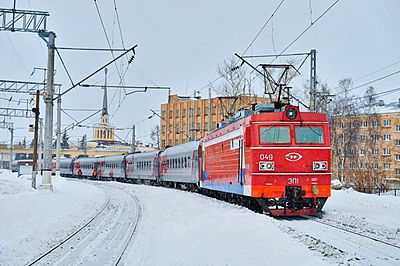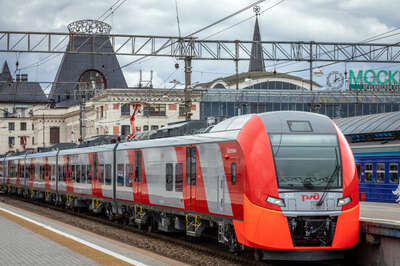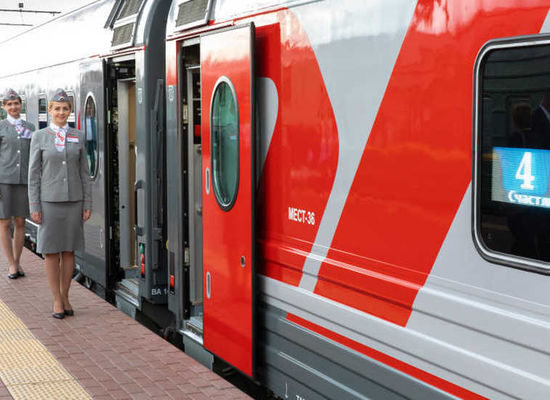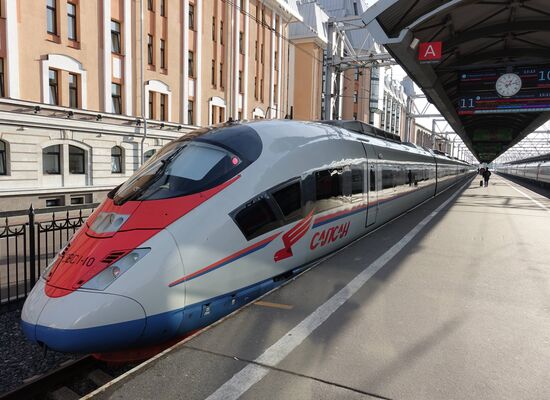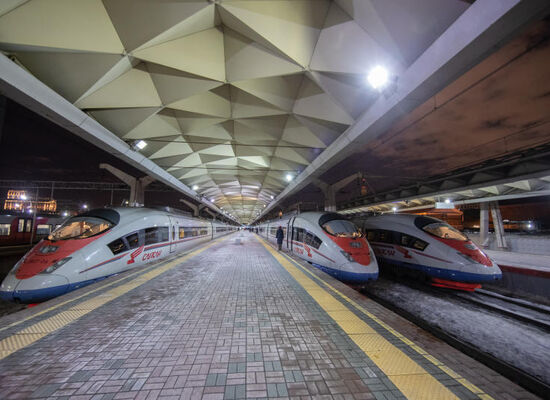Moscow to St. Petersburg Trains
Every Moscow St.Petersburg train has a different character, read the descriptions to learn more
Moscow to St. Petersburg Train Route
Most Moscow to St. Petersburg trains travel without stops. Long-distance trains coming from the South of Russia make up to 5-6 stops on Moscow to St. Petersburg leg. The most popular stops are Tver and Bologoye.
On the Moscow to St. Petersburg route, there is a huge variety of trains from which to choose. From 8-hour overnight trains to high-speed day trains, from the luxurious to the basic – you can always find a train that will suit your needs. The same trains run on the St. Petersburg to Moscow route. Electronic tickets are available on both routes, making your travel arrangements quick and easy.
Distance
645 km
Up to 40 trains
per day
2-6 stops
on the way
Fastest train
3 h 30 min
Slowest train
10 h 22 min
Price from
21 USD
Moscow to St. Petersburg Train Tickets
based on 1249 customer reviews
Frequently Asked Questions From Our Travelers
There are high speed and overnight trains available on this route. The fastest train called Sapsan takes 3.5 - 4 hours, regular overnight trains take 8 - 10 hours. There are several overnight trains offering different levels of comfort including the famous Grand Express and Red Arrow trains.
In St Petersburg, the Sapsan arrives and departs from Moscovsky Train Station, Nevsky Prospect 85, Metro Ploshad Vosstania. In Moscow, for all Sapsan trains running between Moscow and St Petersburg it is Leningradsky Train Station, located at Komsomolskaya Ploshad 3, Metro Komsomolskaya. Sapsan trains operating on the Nizhny Novgorod to St Petersburg route arrive and depart from Kursky Train Station, Zemlyanoi Val, 29, Metro Kurskaya.
Each 2nd and 3rd class passenger is allowed to bring up to 36 kg of hand luggage. 1st class passengers can carry up to 50 kg. The sum of the hand luggage's three dimensions should not exceed 180 cm. Children under 4 travelling on a free ticket (without a separate seat) are not granted a separate piece of luggage.
In general, there is no WiFi on Russian trains except for the Sapsan train traveling between Moscow and St. Petersburg.
Though the price and time on board is almost the same when you travel by air or by train, traveling by a high speed Sapsan train is considered to be the most convenient and fastest way to travel from Moscow to St Petersburg. Train stations in both cities are in the city center so the travel time is significantly shorter when compared to traveling by plane which includes airport check-in and traveling to and from the airport. Another advantage to the train is that passengers can bring up to 36 kg of hand luggage without paying anything extra. Sapsan seats are much more comfortable than airplane seats and you can also enjoy a nice meal at a reasonable price on board.
Testimonials
“
Great website to book Russian trains
I was traveling from SPB to MOW on 12 Sept. Booked 2 tickets for Sapsan through Russianrail.com, the booking experience has been great and very very easy. Got our tickets the same day along with the choice of seats we had requested. Russian rail.com is highly recommended as they give out the best fares compared to other Russian train websites and every detail is in English. The website is very informative for first time Non Russian speaking travelers. Next visit is in May 2020 with family and I would gladly use Russianrail.com to book tickets from Kazan to to SPB....
“
Excellent service
Excellent service. It was easy to select and book online for the SAPSAN tickets from Moscow to St. Petersburg.
“
Overall this has been an amazing experience
Overall this has been an amazing experience. I appreciate the patience and professionalism. The culture in Russia is a beautiful thing. I would highly recommend this company and look forward an additional visit.
“
My experience with RussianRail.com was great
My experience with RussianRail.com was great. The system is user friendly and the communication thorough and frequent. The two Saspan train trips between Moscow and St. Petersburg were the best transport experiences of our three week long trip in Russia and the Caucasus. The tickets were excepted without any problems and the friendly, yet professional hostess could even assist us with some English. Truly a world class experience, thank you.
“
Totally seamless experience
Totally seamless experience. The Sapsan tickets arrived just as promised, and everything went perfectly on the train. Not much more you can ask for!
“
A repeat customer
I recently used Russian Rail for the third time and found the service to be excellent and exceptionally professional. At about the same time I made my reservations my son made reservations with a competing company. We made separate reservations since our start and stop dates of travel were different. The problems my son experienced are too numerous to detail in this space, but suffice it to say he had to eventually cancel with that company. His experience makes me especially appreciative of the service I have received with Russian Rail.
History of the Moscow – St. Petersburg Railway
Where the Train Journey Begins
The journey from Moscow to St. Petersburg begins at what locals call the Three Station Square (officially Komsomolskaya Square). The clocks of Leningradsky, Yaroslavsky and Kazansky Stations all tower over the square. It’s hard to think of a place on earth that’s more infused with the spirit of railway adventure. There’s even a golden statue of the minister who constructed Russia’s first railways at the square’s center. In Russia, train stations are traditionally named after the largest city on their line.
Test your knowledge of Russian history: see if you can guess the name of the station heading the Moscow – St. Petersburg train line before reading on!
Those familiar with soviet history should have chosen Leningradsky Station. Early on in the USSR, Saint Petersburg was renamed Leningrad (Lenin’s city). Though the city's imperial name was eventually restored by the will of the people, the station’s name was never updated. Similarly, the official name of the Moscow-Saint Petersburg railway is still “Oktyabrskaya”, even though it was originally named "Nikolskoye” after the Tsar.
The style of the stations on Komsomolskaya square differ vastly, despite having all been built in the mid-19th century. Those heading to St. Petersburg needn’t worry about confusing Leningradsky station with the others, as it is the largest and grandest by far. The Oktyabrskaya line carries around 140 million passengers yearly with a record speed of 3.5 hours from end to end. Impressive; especially when compared to the original journey time of 22 hours!
Royal Beginnings
The Oktyabrskaya line exclusively carries passengers now. But, initially, it was built to replace cargo ships travelling between Russia’s two great cities. Back in Nikolai I’s rule, a forward-thinking German businessman named Franz Gerstner began badgering the Tsar with his grand idea to lay Russia’s first rail tracks from Saint Petersburg to Nizhny Novgorod, via Moscow. By that time, Britain already had working railways and so, after a bit of persuasion, the Emperor set up a commission to consider Franz’s proposal.
The commission accused the plan of being too ambitious and self-centered. In return for the boundless profit promised, the German professor demanded the exclusive right to the construction of railways within the Russian empire for two decades. After months of deliberation, the project was not allowed to steam ahead. Instead of a thousand-kilometer line, Franz had to content himself with the construction of a 27km track from St. Petersburg to Tsarskoye Selo which opened in 1837.
A couple years later, the Railways commission rejected yet another proposal from Melnikov, a talented Russian rail engineer who had been sent to study in the USA by the Emperor. Even the promise of speeds of up to 37km/h couldn’t allay their alarm at the 43 million rouble bill. Instead, they supported the creation of tracks for horse-drawn carriages which were cheaper and familiar (unlike railways which were viewed with suspicion at the time). This time, however, Emperor Nikolai simply overruled the government bureaucrats and signed a decree on the construction of the St. Petersburg - Moscow railway. The year was 1842. In under 10 years, a 644 km track connected Russia’s main cities.
Smooth runnings?
After a battalion of soldiers had been safely dispatched along the new railway line, the Tsar, his family and entire entourage ventured to take the train journey from Saint Petersburg to Moscow in the autumn of 1851.
A decade had not been sufficient to complete all the work. Temporary “gardens” were planted around stops on the track and well-dressed workers were ordered to stroll along the tracks in an attempt to distract the Tsar from the inadequacies. Nikolai I was not disappointed. But the same could not be said for the thousands of ordinary passengers who took their first train journey along these tracks.
Initially, the trains had no heating, no toilets and no enterprising babushkas selling pies. There were three classes, but the only defining feature of the blue, first-class carriages was slightly plumper seating. The journey took 22 hours at best. At worst, the trains could stop for 12 hours at a time. Oftentimes, passengers would trudge to the nearest village to avoid frostbite while the trains were repaired. Yet, compared to the poor souls who laboured on the tracks for 10 years before, they had it easy.
Did you know? It is thought that the following lines from Nekrasov’s poem “The Railway” were written about the construction of the Oktyabrskaya line:
Straight track: narrow embankment,
Poles, rails, bridges.
To both sides all those Russian bones…
How many of them? Vanyetchka, do you know?
Only one steam-excavation machine was used on a marginal fraction of the train tracks from Moscow to Saint Petersburg. The remaining 600+ kilometres were crafted entirely by human hands.
Triumphant finish
Each passing year, the trains became more reliable and the Oktyabrskaya railway grew in popularity. Before the end of the century, so-called “courier trains” were making the journey in 13 hours. By 1913, the fastest passenger trains were making it in 8 hours. The original series C steam locomotive which allowed for this achievement by reaching speeds of 100km/h can be seen at the Varshavsky Railway Station Museum in St Petersburg.
Not all of the Oktyabrskaya railway’s history lies in museums. You can still buy train tickets for an overnight train journey from Moscow to St. Petersburg on the famous “Red Arrow” which took its maiden voyage in 1931. Despite the name, its carriages were originally all blue as the train had been assembled from 1st class, Tsarist carriages. Startlingly, 1st class wasn’t luxe enough for the Soviet leadership and so the carriages were revamped to include a new class: SV.
The blockade of Leningrad during WWII put the progress of the Moscow-St Petersburg train line on pause but did no major damage. To this day, trains arriving from Moscow chug into the same, grand Moskovsky Railway Station in St Petersburg that Tsar Nikolai I departed from in 1851.
Once you have your tickets, look forward to a wonderful, smooth
and enjoyable journey through the Russian countryside.
Buy your ticket safely and securely and then sit back
and enjoy the ride!
Recommended by
Our travel group under the names Express to Russia, Russian Rail and Trans-Europe Express has been recommended and/or accredited by:

A portion of your order goes to helping underprivileged Russian children.
